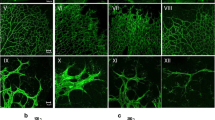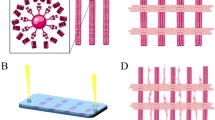Abstract
NOTCH signalling is an evolutionarily conserved juxtacrine signalling pathway that is essential in development. Jagged1 (JAG1) and Delta-like ligand 4 (DLL4) are transmembrane NOTCH ligands that regulate angiogenesis by controlling endothelial cell (EC) differentiation, vascular development and maturation. In addition, DLL4 could bypass its canonical cell–cell contact-dependent signalling to influence NOTCH signalling and angiogenesis at a distance when it is packaged into extracellular vesicles (EVs). However, it is not clear whether JAG1 could also be packaged into EVs to influence NOTCH signalling and angiogenesis. In this work, we demonstrate that JAG1 is also packaged into EVs. We present evidence that JAG1-EVs inhibit NOTCH signalling and regulate EC behaviour and function. JAG1-EVs inhibited VEGF-induced HUVEC proliferation and migration in 2D culture condition and suppressed sprouting in a 3D microfluidic microenvironment. JAG1-EV treatment of HUVECs leads to a reduction of Notch1 intracellular domain (N1-ICD), and the proteasome and the intracellular domain of JAG1 (JAG1-ICD) are both required for this reduction to occur. These findings reveal a novel mechanism of JAG1 function in NOTCH signalling and ECs through EVs.







Similar content being viewed by others
References
Bray S (2006) Notch signalling: a simple pathway becomes complex. Nat Rev Mol Cell Biol 7:678–689. https://doi.org/10.1038/nrm2009
Gerhardt H, Golding M, Fruttiger M et al (2003) VEGF guides angiogenic sprouting utilizing endothelial tip cell filopodia. J Cell Biol 161:1163–1177. https://doi.org/10.1083/jcb.200302047
Kume T (2009) Novel insights into the differential functions of Notch ligands in vascular formation. J Angiogenes Res 1:8. https://doi.org/10.1186/2040-2384-1-8
Blanco R, Gerhardt H (2013) VEGF and Notch in tip and stalk cell selection. Cold Spring Harb Perspect Med. https://doi.org/10.1101/cshperspect.a006569
Lobov IB, Renard RA, Papadopoulos N et al (2007) Delta-like ligand 4 (Dll4) is induced by VEGF as a negative regulator of angiogenic sprouting. Proc Natl Acad Sci USA 104:3219–3224. https://doi.org/10.1073/pnas.0611206104
Suchting S, Freitas C, le Noble F et al (2007) The Notch ligand Delta-like 4 negatively regulates endothelial tip cell formation and vessel branching. Proc Natl Acad Sci 104:3225–3230. https://doi.org/10.1073/pnas.0611177104
Hellström M, Phng L-K, Hofmann JJ et al (2007) Dll4 signalling through Notch1 regulates formation of tip cells during angiogenesis. Nature 445:776–780. https://doi.org/10.1038/nature05571
Benedito R, Roca C, Sörensen I et al (2009) The notch ligands Dll4 and Jagged1 have opposing effects on angiogenesis. Cell 137:1124–1135. https://doi.org/10.1016/j.cell.2009.03.025
Raposo G, Stoorvogel W (2013) Extracellular vesicles: exosomes, microvesicles, and friends. J Cell Biol 200:373–383. https://doi.org/10.1083/jcb.201211138
Sheldon H, Heikamp E, Turley H et al (2010) New mechanism for Notch signaling to endothelium at a distance by delta-like 4 incorporation into exosomes. Blood 116:2385–2394. https://doi.org/10.1182/blood-2009-08-239228
Sharghi-Namini S, Tan E, Ong L-LS et al (2014) Dll4-containing exosomes induce capillary sprout retraction in a 3D microenvironment. Sci Rep 4:4031. https://doi.org/10.1038/srep04031
Kilani RT, Chavez-mun C (2009) Profile of exosomes related proteins released by differentiated and undifferentiated human keratinocytes. J Cell Physiol 221:221–231. https://doi.org/10.1002/jcp.21847
Liang B, Peng P, Chen S et al (2013) Characterization and proteomic analysis of ovarian cancer-derived exosomes. J Proteomics 80:171–182. https://doi.org/10.1016/j.jprot.2012.12.029
Beckler MD, Higginbotham JN, Franklin JL et al (2013) Proteomic analysis of exosomes from mutant KRAS colon cancer cells identifies intercellular transfer of mutant KRAS. Mol Cell Proteomics. https://doi.org/10.1074/mcp.M112.022806
Lazar I, Clement E, Ducoux-petit M et al (2015) Proteome characterization of melanoma exosomes reveals a specific signature for metastatic cell lines Ikrame. Pigment Cell Melanoma Res 28:464–475. https://doi.org/10.1111/pcmr.12380
Sethi N, Dai X, Winter CG, Kang Y (2011) Tumor-derived Jagged1 promotes osteolytic bone metastasis of breast cancer by engaging notch signaling in bone cells. Cancer Cell 19:192–205. https://doi.org/10.1016/j.ccr.2010.12.022
Brownlee Z, Lynn KD, Thorpe PE, Schroit AJ (2014) A novel “salting-out” procedure for the isolation of tumor-derived exosomes. J Immunol Methods 407:120–126. https://doi.org/10.1016/j.jim.2014.04.003
Mitchell JP, Court J, Mason MD et al (2008) Increased exosome production from tumour cell cultures using the Integra CELLine culture system. J Immunol Methods 335:98–105. https://doi.org/10.1016/j.jim.2008.03.001
Farahat WA, Wood LB, Zervantonakis IK et al (2012) Ensemble analysis of angiogenic growth in three-dimensional microfluidic cell cultures. PLoS ONE. https://doi.org/10.1371/journal.pone.0037333
Lötvall J, Hill AF, Hochberg F et al (2014) Minimal experimental requirements for definition of extracellular vesicles and their functions: a position statement from the international society for extracellular vesicles. J Extracell Vesicles 3:1–6. https://doi.org/10.3402/jev.v3.26913
Ribatti D, Crivellato E (2012) “Sprouting angiogenesis”, a reappraisal. Dev Biol 372:157–165. https://doi.org/10.1016/j.ydbio.2012.09.018
Noseda M, Chang L, McLean G et al (2004) Notch activation induces endothelial cell cycle arrest and participates in contact inhibition: role of p21Cip1 repression. Mol Cell Biol 24:8813–8822. https://doi.org/10.1128/MCB.24.20.8813-8822.2004
Takeshita K, Satoh M, Ii M et al (2007) Critical role of endothelial Notch1 signaling in postnatal angiogenesis. Circ Res 100:70–78. https://doi.org/10.1161/01.RES.0000254788.47304.6e
D’Souza B, Meloty-Kapella L, Weinmaster G (2010) Canonical and non-canonical notch ligands. Curr Top Dev Biol 92:73–129. https://doi.org/10.1016/S0070-2153(10)92003-6
Kim MY, Jung J, Mo JS et al (2011) The intracellular domain of Jagged-1 interacts with Notch1 intracellular domain and promotes its degradation through Fbw7 E3 ligase. Exp Cell Res 317:2438–2446. https://doi.org/10.1016/j.yexcr.2011.07.014
Metrich M, Bezdek Pomey A, Berthonneche C et al (2015) Jagged1 intracellular domain-mediated inhibition of Notch1 signalling regulates cardiac homeostasis in the postnatal heart. Cardiovasc Res 108:74–86. https://doi.org/10.1093/cvr/cvv209
Pedrosa AR, Trindade A, Fernandes AC et al (2015) Endothelial jagged1 antagonizes Dll4 regulation of endothelial branching and promotes vascular maturation downstream of Dll4/Notch1. Arterioscler Thromb Vasc Biol 35:1134–1146. https://doi.org/10.1161/ATVBAHA.114.304741
Kadesch T (2000) Notch signaling: a dance of proteins changing partners. Exp Cell Res 260:1–8. https://doi.org/10.1006/excr.2000.4921
Öberg C, Li J, Pauley A et al (2001) The notch intracellular domain is ubiquitinated and negatively regulated by the mammalian Sel-10 homolog. J Biol Chem 276:35847–35853. https://doi.org/10.1074/jbc.M103992200
Liebler SS, Feldner A, Adam MG et al (2012) No evidence for a functional role of bi-directional notch signaling during angiogenesis. PLoS ONE 7:1–10. https://doi.org/10.1371/journal.pone.0053074
Heusermann W, Hean J, Trojer D et al (2016) Exosomes surf on filopodia to enter cells at endocytic hot spots, traffic within endosomes, and are targeted to the ER. J Cell Biol 213:173–184. https://doi.org/10.1083/jcb.201506084
Gong J, Körner R, Gaitanos L, Klein R (2016) Exosomes mediate cell contact-independent ephrin-Eph signaling during axon guidance. J Cell Biol 214:35–44. https://doi.org/10.1083/jcb.201601085
Author information
Authors and Affiliations
Corresponding author
Electronic supplementary material
Below is the link to the electronic supplementary material.
Rights and permissions
About this article
Cite this article
Tan, E., Asada, H.H. & Ge, R. Extracellular vesicle-carried Jagged-1 inhibits HUVEC sprouting in a 3D microenvironment. Angiogenesis 21, 571–580 (2018). https://doi.org/10.1007/s10456-018-9609-6
Received:
Accepted:
Published:
Issue Date:
DOI: https://doi.org/10.1007/s10456-018-9609-6




